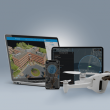Cash-strapped public-safety agencies adopting non-P25 technologies with increasing frequency, NPSTC says
In addition, local governments’ communications investment decisions often are driven by the needs of the larger government enterprise, Lenihan said.
“There are cases where a municipality doesn’t want to build two systems,” he said. “They’ve got a police and fire department. They want their trash trucks, public works and parks-and-recreation [personnel] to be on the same radio network, for economy of scale, and they get sold a digital system that won’t interoperate with federal, state agencies or larger agencies around.
“I think that’s how they’re making their way into public safety—a municipality may just basically bundle all of their services onto one radio system.”
NPSTC has not conducted a survey to determine how many public-safety agencies are adopting non-P25 technologies, but anecdotal evidence clearly indicates that the trend is occurring, with first-responder agencies migrating to NXDN, DMR and MotoTRBO systems in states like Kentucky, Florida and Georgia, Lenihan said.
“We’re gradually being fragmented after herding all of the cats to P25,” he said. “As the life cycles of the systems time out, it’s looking more like people are choosing a variety [of LMR technologies].
“Quite frankly, the responder doesn’t necessarily care which technology [is used]. It just has to be reliable, resilient, and it has to work.”
In addition, a growing number of critical-infrastructure entities—for example, utilities, airports and transit authorities—are opting for non-P25 digital radio systems, including TETRA, Lenihan said.
Meanwhile, the impact of push-to-talk-over-cellular (PoC) already is impacting the enterprise space and potentially will influence the public-safety and critical-communications arenas as FirstNet is deployed and mission-critical push-to-talk (MCPTT) offerings become available during the next few years, Lenihan said.
“I think, in a lot of areas, push to talk over LTE is going to have a dominant role in push to talk, because of the coverage, the density of sites and the reliability of it,” Lenihan said. “People are going to get comfortable with it. Even if it is not mission critical, I think there is going to be a behavior shift, once they use it for a period of time without fail.”
While non-P25 usage is a growing trend for rural and cash-strapped public-safety agencies, Lenihan said he does not believe it will become an issue in metropolitan areas in the near future.
“I think the big municipalities have already made the investment in P25, so that’s pretty much entrenched,” Lenihan said. “It’s going to be the small towns that are isolated by distance and maybe don’t interact with adjacent towns and cities on a regular basis … they’re going to take care of their own needs.”
This small-town trend to non-P25 technologies is impacting larger agencies’ purchasing decisions, because the larger agencies are buying non-P25 subscribers to ensure that their first responders can interoperate with smaller agencies in mutual-aid scenarios, Lenihan said.
“The pressure is that [the larger agencies] either buy radios that will work with your mutual-aid partners, or you somehow encourage [smaller agencies] to buy P25 radios,” Lenihan said, noting that having the larger agency buying the less-expensive non-P25 subscribers is often the more practical option.










